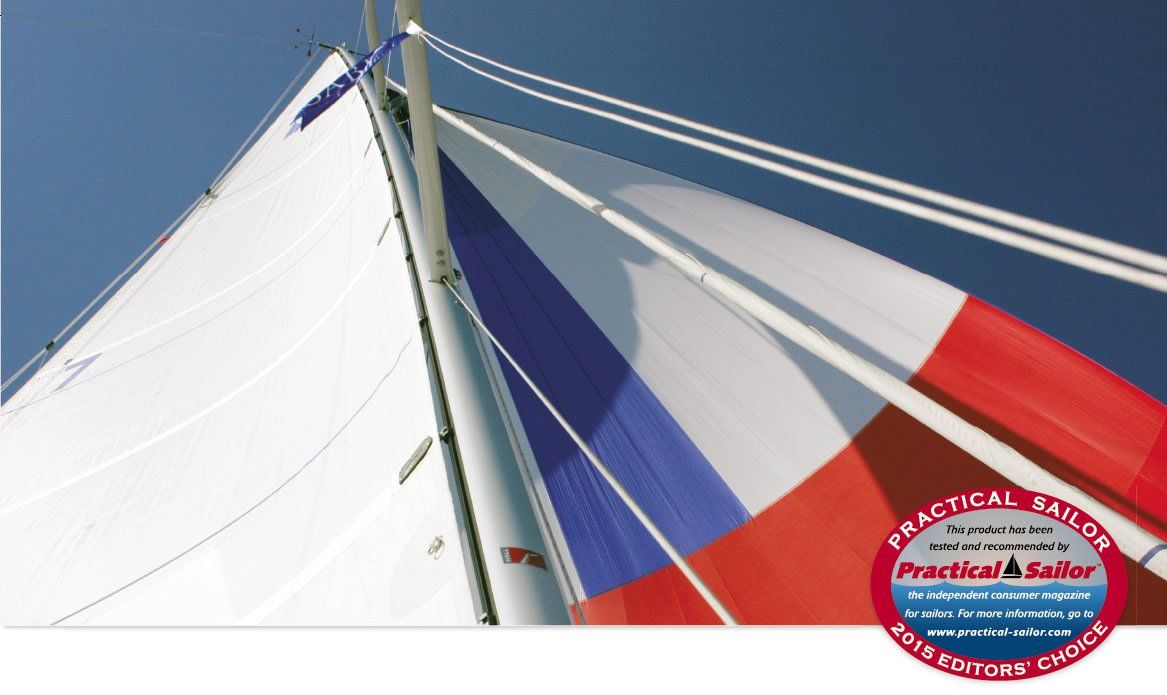
Each fall, Practical Sailor editors sort through the best test products of the past year to pick those deserving of a spot on our PS Editors Choice roster. To be named to the list, products must earn the Best Choice rating among their respective peers and clearly stand out above others in their field.
Chosen from test products covered in the September 2014 through the August 2015 issues, this years Editors Choice picks represent nearly every category of marine gear-from rigging and hardware to maintenance, systems, electronics, and apparel. These products are the if-money-were-no-object picks. Budget-minded and small-boat sailors may be better suited with our Budget Buy or Recommended picks in certain test categories; for more on those products, refer to the online archive articles cited in this report.
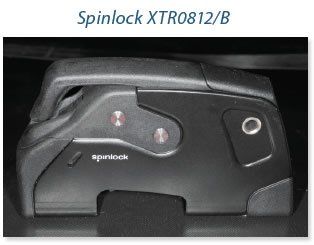
Rigging & Hardware
Spinlock rope clutch
In the November 2014 issue, we compared rope clutches from Antal, Garhauer, Karver, Lewmar, Ronstan, and Spinlock. Testers were amazed by the wide range of approaches to the seemingly simple task of seizing a rope.
The clutches faced a series of bench tests using different rope of varying sizes. The protocol included tension testing, grip testing, and pull tests; testers also considered construction quality, mounting support and ergonomic factors.
The top performer was the Spinlock XTR0812/B, which comes with what the maker calls a reactor cam that engages top and bottom line grippers. Toothed edges on both the top and bottom aid the locking cam design. Testers found this approach worked very well on smaller-diameter ropes. The modular design makes it easier to disassemble the operational parts while the frame remains attached to the boat. The combination of stainless steel and fiber-filled plastic components and smooth-working cam levers make this a user-friendly clutch.
The quick disassembly and all-around performance of the XTR made it our Editors Choice pick.
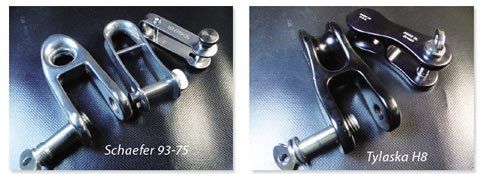
Schaefer & Tylaska Shackles
A mainsail halyard shackle needs to be as reliable as an on/off switch on a table saw. In the September 2014 issue, we tested hard and soft shackles to determine which would best serve the cruiser, who prizes durability and strength, and the racer, who makes lightweight a priority. Testers evaluated metal shackles from Schaefer Marine, Ronstan International, and Tylaska, as well as fiber shackle from Equiplite and Colligo. The protocol included faux-halyard bench tests-repeatedly point-loading pins and loop locks-and handling observations in the workshop and on board.
The heavy-duty Schaefer 93-75 earned a spot on the Editors Choice lineup as the best mainsail halyard shackle for a cruiser because of its structural quality and tried-and-proven design. The non-magnetic, investment cast 93-75 utilizes a dual-thread clevis pin that is threaded at both ends, a very useful design features for cruisers. The finely finished shackle got high marks for engineering and attention to detail.
The top pick, and Editors Choice winner, among shackles for racing sailors looking for a lightweight, metal mainsail shackle was the Tylaska H8. This machined, high-strength, hard-anodized aluminum shackle has a built-in thimble that can be used in either 2:1 or 1:1 halyard configurations. A screw-type 17-4PH clevis pin positively locks the gate. The H8 features offset drilled holes for the clevis pin; this design helps spread the shackles load more easily.
Peerless anchor shackle
Shackles are generally available in two grades: Grade A and the stronger Grade B. For our anchor shackle test in the August 2015 issue, we focused on Grade B shackles from Peerless, Campbell, Crosby, and Canada Metals Pacific (CMP)/Titan, as these are the established names in the industry. Testing was carried out at J.L. Robertsons, an approved test facility in Newcastle, Australia, on a test rig that is used to certify lifting components for the mining industry.
Peerless is the United States biggest chain manufacturer (Acco). Its Peer-Lift shackles, differentiated from other suppliers by a blue pin, are well suited as anchor shackles. The Peer-Lift quarter-inch, Grade B, shackle we tested had a rated working load limit of 1,500 pounds with a 6:1 safety factor. This gives it a minimum breaking limit of 9,000 pounds. In our test, the shackle exceeded its load limit by almost 10 percent, failing at 9,800 pounds. The failure was at the thread; the pin sheared.
The blue-pin Peerless shackle exceeded all expectations in this evaluation, earning it a spot on this years Editors Choice lineup.
Robline No. 10 whipping twine
In the December 2014 issue, we evaluated various sizes and brands of whipping twine used for handsewn boat projects like lockstitching lines and burying splices. We measured how strong the twines were and learned which ones tangled the easiest. We also tested each type on our chafe machine to see which material best withstood the rigors of use. Testers focused on waxed polyester twine and unwaxed Dyneema twine.
The No. 2 through No. 8 waxed whipping twines from Robline are laid polyester twine, rather than braided, while the Nos. 10 and 15 twines are more heavily waxed and braided, resulting in much better handling and far fewer tangles.
Larger spools and ready availability make any of the Robline waxed polyester twines a good option, but the braided No. 10 was our favorite for general use. It has excellent strength and makes sewing easier, garnering it a spot on the Editors Choice roster.
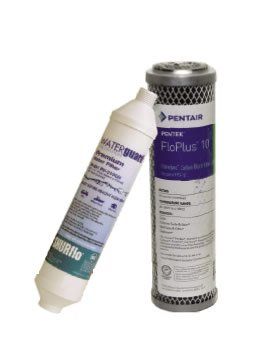
Freshwater System
Shurflo & Hydronix filters
When significant accumulations of dirt and biomass are allowed to build up in the tank, no final filtration system can make the water right again. Water-pump life is reduced by sediment, and fungal mats will clog your water lines. In 2015, we looked at how to prevent contaminants from entering your onboard freshwater tank (PS June 2015), chemical treatments for cleaning tanks and keeping tank water fresh (PS July 2015), and filtration systems between the tank and faucet that keep tap water sweet and safe (PS August 2015).
We tested common commercial hose-end filters and universal cartridge filters, along with our DIY Baja filter. Our testing included basic observation, tests for flow rates and chlorine removal, and filter dissection when expended.
The best off-the-shelf, hose-end filter was Shurflos Waterguard filter, made by Pentair Residential Filtration. Like most other filters in this category, these are also filled with a carbon/KDF blend, but the Waterguard filters provide slower flow rate due to finer filtration (5 microns). Finer filtration means less chance of biological growth, and we like that, but whether this is acceptable may depend on your tank size. At $37 each, these are not cheap, but they last about two years.
Testers top pick for a cartridge filter was the Hydronix SPC-25-1010, a 10-micron pleated polyester element. The Hydronix represents the optimum compromise of flow, filtration, and usable life. The molded ends can serve as gaskets, a much better arrangement than a no-gasket system, at some increase in cost. Like the Waterguard filter, the Hydronix is rated for more than 6,000 gallons, which represents 150 40-gallon fill-ups; more than any seasonal coastal sailor will need.
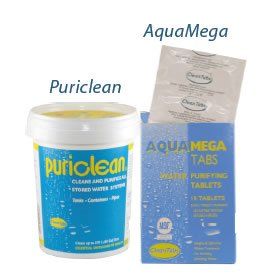
AquaMega & Puriclean tabs
In the July 2015 issue, we compared a host of tank-cleaning products, sanitizing chemicals, and tank-freshening chemicals. We dosed each freshening product into reverse osmosis (RO) water, and then stored the water in our pseudo, mini water tanks. We graded how well the chlorine residual endured after 24 hours, and how well residual odor and taste were removed. We repeated similar tests for tank cleaning-chemicals and tank-sanitizing chemicals. We also placed aluminum corrosion coupons in the solutions and graded them after regular checks during a three-week period; chlorine-induced corrosion is a major concern with aluminum tanks. For real-world testing, we used each of the freshening chemicals during a summer of cruising, dosed as recommended, and evaluated taste.
Testers favorite tank-cleaning product in our test was the AquaMega tablets. Based on sodium dichlorisocyanurinate, AquaMega tablets are available in amounts matched to tank sizes. We observed a more stable residual and much lower aluminum corrosion rates compared to bleach.
The convenient packaging, long shelf life, ease of use (nothing to measure), low corrosion rates, and stable residual made AquaMega our Editors Choice among tank freshening and disinfecting chemicals. It was also our favorite to use.
The sodium dichlorisocyanurinate-based Puriclean Clean Tabs tank sanitizer has the same basic chemistry as the AquaMega Tabs, and it also lasted longer than bleach. Testers noted much lower aluminum corrosion rates with Puriclean than with other sanitizing products. This plus a stable residual earned Puriclean the Editors Choice pick among tank-sanitizing chemicals. Both AquaMega and Puriclean also will work well in aluminum tanks.
Pentek FloPlus-10
Our final filter test focused on carbon-block filters, since these offer the best combination of affordable price, ease of installation, and effectiveness in improving taste and eliminating micro-organisms. Testers sought a filter that would remove chlorine residuals, cysts, and most bacteria with inexpensive and simple 0.5-micron, carbon-block filters. All of the filters we tested can be used to filter water from a reverse osmosis (RO) watermaker.
For the test, we installed a carbon-block filter (Pentek CBC-5) in a 2-by-10 housing to provide faster water flow. With the NSF-certified products, we measured flow rates and chlorine removal efficiency, to confirm what they reported. We used a combination of lab equipment and aquarium test strips during testing; the test strips never conflicted with our lab results.
We evaluated 2-by-10-inch and 2-by-5-inch filters from Pentek, Kx Matrikx, General Ecology, General Electric, and Doulton. The Pentek FloPlus-10 was our favorite all-around choice among NSF-53 filters. It costs more than others (about $16 each), but we liked the combination of high flow-rate, acceptable clogging resistance, a fair price, and an NSF-53 rating.
The 2-by-10-inch FloPlus-10 fits standard housings, is NSF-53 certified to remove cysts, and offers all of the flow and longevity we could ask for. This filter is a good choice for U.S. and around-the-world-sailors.
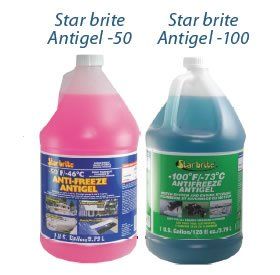
Star brite AntiGel -50 & -100
We tested antifreezes for winterizing potable water systems (PS September 2014) from Star brite, Sudbury, Camco, and West Marine. Winterizing products are formulated using propylene glycol (PG), a relatively non-toxic liquid similar to glycerin, or denatured ethanol, which is generally less expensive and performs much the same function, preventing freezing and bursting. Ethylene glycol, common in engine coolants, is not appropriate for potable water systems because of significant acute toxicity. We tested each product for glycol content, freezing and burst point, corrosion protection, and chemical compatibility.
All of the test products were effective freeze-proofing agents, with some small variation in glycol/alcohol concentration, but the Star brite Antigel -50 and Antigel -100 offered the best value and protection, earning them spots on the Editors Choice list.
A premium propylene-glycol product, Star brites -50-degree Antifreeze and Antigel provided the best freeze- and burst-point protection of the group. It was typically the last to freeze and showed the greatest glycol content. It also performed very well in corrosion testing. It is formulated to be used without being diluted.
A more concentrated version of the Star brite -50, the -100-degree Antifreeze and Antigel has twice the glycol-perfect for boats in extreme climates. The extra glycol allows for inevitable dilution with undrained water.
Engine coolants
Detroit Diesel Power Cool Plus
Our October 2014 search for an engine coolant with corrosion protection focused on light-duty coolants for gasoline engines and heavy-duty products for diesels. The test field included products from Star brite, West Marine, Zerex, and Cummins.
Samples were tested for corrosion protection for two weeks, then cleaned, dried, and evaluated for both a change in appearance and loss in weight. We also tested the products freeze points, and diesel coolants were tested for cavitation pitting; any evidence of pitting or freckling was considered to be a failure.
A common premium factory-fill coolant for heavy-duty trucks, Detroit Diesel Power Cool Plus scored very impressively in all of our corrosion tests. It is available through Detroit Diesel parts dealers as either a concentrate ($20 per gallon) or pre-diluted ($12 per gallon). We rated Power Cool Plus as the Budget Buy and Best Choice pick among engine coolants, garnering it a place on this years Editors Choice lineup.
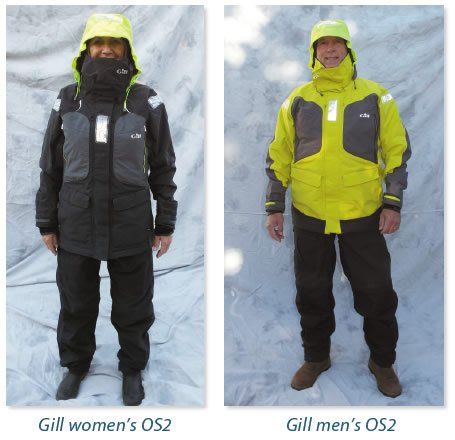
Apparel
Gill OS2 foulies
In early 2015, Practical Sailor tested mid-range, mens and womens foul-weather gear from Gill, Grundens, Helly Hansen, Henri Lloyd, and West Marine. We set the price maximum at approximately $500 for a jacket and bibbed trousers combo. Each foul-weather kit was worn for several months and was subject to a series of rigorous tests designed to measure resistance to the elements, breathability, wearability, reflectivity, functionality, and abrasion resistance.
Testers reported on the mens gear in the February 2015 issue and womens in the March 2015 issue. In both tests, the Gill OS2 kits got top billing. The OS2 jacket and trousers, which rated Good or Excellent in every test category, are the ideal mid-range kit for the serious sailor who is headed offshore but isn’t looking to spend $1,000 on foul-weather gear. Priced at $550 per set, the mens and womens OS2 kits are the Editors Choice because of their versatility, comfort, and superior quality and construction.
Testers noted that the waterproof and windproof mens jacket is comfortable and relatively lightweight with a fleece-lined collar, a mesh liner at the neck and shoulders, and is available in high-visibility colors. Handy details include sufficient pockets, a fluorescent, rollaway hood with good visibility, shock cord at the bottom, and reflective patches. The bibs, which have an elasticized waist, are designed for comfort and can be easily donned, doffed, and adjusted.
The OS2 womens jacket had the same features and high marks for comfort, light weight, quick drying, water and wind resistance, and breathability. The womens trousers have an elasticized waist, a dropseat, and wide, adjustable shoulder straps, and the fastening system at the ankle is superior to other brands tested, testers noted.









































Where in the USA can one purchase AquaMega tablets?